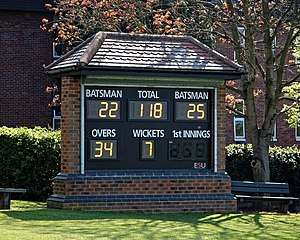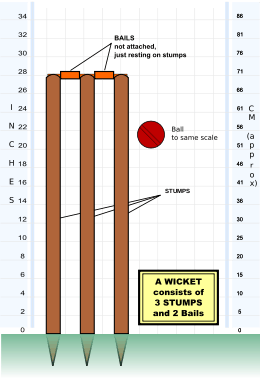Wicket
In cricket, the term wicket has several meanings. First, it is one of the two sets of three stumps and two bails at either end of the pitch.[1] The wicket is guarded by a batsman who, with his bat (and sometimes with his pads, but see the laws on LBW, leg before wicket), attempts to prevent the ball from hitting the wicket and to score runs where possible.

Second, through metonymic usage, the dismissal of a batsman is known as the taking of a wicket,[2] and third, the cricket pitch itself is sometimes referred to (incorrectly, according to the Laws of Cricket) as the wicket.
History
The origin of the word is from wicket gate, a small gate. Originally, cricket wickets had only two stumps and one bail and looked like a gate. The third (middle) stump was introduced in 1775, after Lumpy Stevens bowled three successive deliveries to John Small that went straight through the two stumps rather than hitting them.[3]
Stumps and bails
The size and shape of the wicket has changed several times during the last 300 years; its dimensions and placing is now determined by Law 8 in the Laws of Cricket, thus:
- Law 8: The wickets. The wicket consists of three wooden stumps that are 28 inches (71.12 cm) tall. The stumps are placed along the batting crease with equal distances between each stump. They are positioned so they are 9 inches (22.86 cm) wide. Two wooden bails are placed in shallow grooves on top of the stumps. The bails must not project more than 0.5 inches (1.27 cm) above the stumps, and must, for cricket, be 4.31 inches (10.95 cm) long.
There are also specified lengths for the barrel and spigots of the bail. There are different specifications for the wickets and bails for junior cricket. The umpires may dispense with the bails if conditions are unfit (e.g., if it is windy they might fall off by themselves).[4] Further details on the specifications of the wickets are contained in Appendix D to the laws.
Putting down a wicket
For a batsman to be dismissed by being bowled, run out, stumped or hit wicket, his wicket needs to be put down. What this means is defined by Law 29. A wicket is put down if a bail is completely removed from the top of the stumps, or a stump is struck out of the grounds by the ball, the striker's bat, the striker's person (or by any part of his clothing or equipment becoming detached from his person), a fielder (with his hand or arm, and provided that the ball is held in the hand or hands so used, or in the hand of the arm so used). A 2010 amendment to the Laws clarified the rare circumstance where a bat breaks during the course of a shot and the detached debris breaks the wicket; the wicket has been put down in this circumstance.[5] The wicket is also put down if a fielder pulls a stump out of the ground in the same manner.

If one bail is off, removing the remaining bail or striking or pulling any of the three stumps out of the ground is sufficient to put the wicket down. A fielder may remake the wicket, if necessary, to put it down to have an opportunity of running out a batsman.
If however both bails are off, a fielder must remove one of the three stumps out of the ground with the ball, or pull it out of the ground with a hand or arm, provided that the ball is held in the hand or hands so used, or in the hand of the arm so used.
If the umpires have agreed to dispense with bails, because, for example, it is too windy for the bails to remain on the stumps, the decision as to whether the wicket has been put down is one for the umpire concerned to decide. After a decision to play without bails, the wicket has been put down if the umpire concerned is satisfied that the wicket has been struck by the ball, by the striker's bat, person, or items of his clothing or equipment separated from his person as described above, or by a fielder with the hand holding the ball or with the arm of the hand holding the ball.
Dismissal of a batsman

The dismissal of a batsman is known as the taking of a wicket. The batsman is said to have lost his wicket, the batting side is said to have lost a wicket, the fielding side to have taken a wicket, and the bowler is also said to have taken his (i.e. the batsman's) wicket, if the dismissal is one of the types for which the bowler receives credit. This language is used even if the dismissal did not actually involve the stumps and bails in any way, for example, a catch. Though note that the other three of the five most common methods of dismissal (bowled, LBW, run out, and stumped) involve the stumps and bails being put down.
The word wicket has this meaning in the following contexts:
Scoring
A team's score is described in terms of the total number of runs scored and the total number of wickets lost.
Bowling analyses
The number of wickets taken is a primary measure of an individual bowler's ability, and a key part of a bowling analysis.
Batting partnerships
The sequence of time over which two particular batsmen bat together, a partnership, is referred to as a specifically numbered wicket when discriminating it from other partnerships in the innings.
- The first wicket partnership is from the start of the innings until the team loses its first wicket, i.e. one of the first two batsmen is dismissed.
- The second wicket partnership is from when the third batsman starts batting until the team loses its second wicket, i.e. a second batsman is dismissed.
- etc...
- The tenth wicket or last wicket partnership is from when the eleventh (last) batsman starts batting until the team loses its tenth (last) wicket, i.e. a tenth (last) batsman is dismissed.
Winning by number of wickets
A team can win a match by a certain number of wickets. This means that they were batting last, and reached the winning target with a certain number of batsmen still not dismissed. For example, if the side scored the required number of runs to win with only three batsmen dismissed, they are said to have won by seven wickets (as a team's innings ends when ten batsmen are dismissed).
The pitch
The word wicket is also sometimes used to refer to the cricket pitch itself.[6][7] According to the Laws of Cricket, this usage is incorrect, but it is in common usage and commonly understood by cricket followers. The term sticky wicket refers to a situation in which the pitch has become damp, typically due to rain or high humidity. This makes the path of the ball more unpredictable thus making the job of defending the stumps that much more difficult. The full phrase is thought to have originally been "to bat on a sticky wicket." Such pitches were commonplace at all levels of the game (i.e. up to Test match level) until the late 1950s.
In other sports
The arches used in croquet and roque are sometimes referred to as wickets, especially in American English. These arches descend from the ancestral game of ground billiards (which may also be related to cricket), and were formerly called the hoop, arch or port. The port remained a prominent feature of indoor table billiards until well into the 18th century.[8]
See also
- Cricket terminology
References
- "Law 8 – The wickets". MCC. Retrieved 29 September 2017.
- "A glossary of cricket terms". ESPNcricinfo. 6 March 2006.
- "The origins of cricket jargon". BBC Bitesize. Retrieved 17 November 2018.
- "Strange sight at Old Trafford as England and Australia forced to play without bails". thecricketer.com. 4 September 2019. Retrieved 18 December 2019.
- "MCC announce eight Law changes". 30 September 2010. Archived from the original on 21 February 2011.
- "wicket – Definition of wicket in English by Oxford Dictionaries". Oxford Dictionaries – English.
- "Wicket definition and meaning – Collins English Dictionary". collinsdictionary.com.
- Clare, Norman (1996) [1985]. Billiards and Snooker Bygones (amended ed.). Princes Risborough, England: Shire Publications. pp. 3, 6, 7. ISBN 0-85263-730-6.
